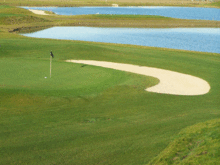Agronomy is the science and technology of producing and using plants by agriculture for food, fuel, fiber, chemicals, recreation, or land conservation. Agronomy has come to include research of plant genetics, plant physiology, meteorology, and soil science. It is the application of a combination of sciences such as biology, chemistry, economics, ecology, earth science, and genetics. Professionals of agronomy are termed agronomists.
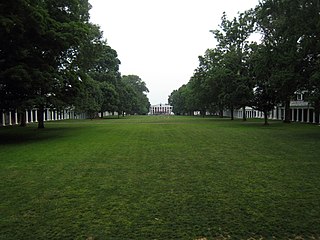
A lawn is an area of soil-covered land planted with grasses and other durable plants such as clover which are maintained at a short height with a lawn mower and used for aesthetic and recreational purposes—it is also commonly referred to as part of a garden. Lawns are usually composed only of grass species, subject to weed and pest control, maintained in a green color, and are regularly mowed to ensure an acceptable length. Lawns are used around houses, apartments, commercial buildings and offices. Many city parks also have large lawn areas. In recreational contexts, the specialised names turf, parade, pitch, field or green may be used, depending on the sport and the continent.
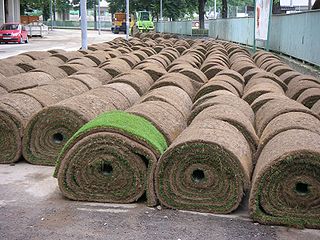
Sod is the upper layer of turf that is harvested for transplanting. Turf consists of a variable thickness of a soil medium that supports a community of turfgrasses.
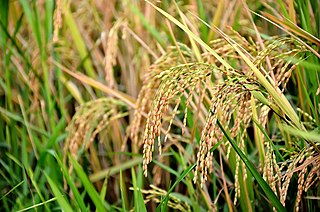
Oryza sativa, having the common name Asian cultivated rice, is the much more common of the two rice species cultivated as a cereal, the other species being O. glaberrima, African rice. It was first domesticated in the Yangtze River basin in China 13,500 to 8,200 years ago.

Zoysia is a genus of creeping grasses widespread across much of Asia and Australia, as well as various islands in the Pacific. These species, commonly called zoysia or zoysiagrass, are found in coastal areas or grasslands. It is a popular choice for fairways and teeing areas at golf courses. The genus is named after the Slovenian botanist Karl von Zois (1756–1799).

Paspalum notatum, known commonly as bahiagrass, common bahia, and Pensacola bahia, is a tropical to subtropical perennial grass. It is known for its prominent V-shaped inflorescence consisting of two spike-like racemes containing multiple tiny spikelets, each about 2.8–3.5 millimetres (0.11–0.14 in) long.

Poa annua, or annual meadow grass, is a widespread low-growing turfgrass in temperate climates. Notwithstanding the reference to annual plant in its name, perennial bio-types do exist. This grass originated as a hybrid between Poa supina and Poa infirma. Major chromosomal rearrangements after polyploidy have contributed to variation in genome size in Poa annua.

Bouteloua dactyloides, commonly known as buffalograss or buffalo grass, is a North American prairie grass native to Canada, Mexico, and the United States. It is a short grass found mainly on the High Plains and is co-dominant with blue grama over most of the shortgrass prairie. Buffalo grass in North America is not the same species of grass commonly known as "buffalo" in Australia.

Zoysia matrella (L.) Merr., commonly known as Manila grass, is a species of mat-forming, perennial grass native to temperate coastal southeastern Asia and northern Australasia, from southern Japan, Taiwan, and southern China south through Thailand, Indonesia, Malaysia and the Philippines to northern Australia, and west to the Cocos Islands in the eastern Indian Ocean.

Napa cabbage is a type of Chinese cabbage originating near the Beijing region of China that is widely used in East Asian cuisine. Since the 20th century, it has also become a widespread crop in Europe, the Americas, and Australia. In much of the world, it is referred to as "Chinese cabbage". In Australia, it is sometimes referred to as "wombok".

Aromatic rice is one of the major types of rice. It is a medium- to long-grained rice. It is known for its nutty aroma and taste, which is caused by the chemical compound 2-acetyl-1-pyrroline. Varieties of aromatic rice include Ambemohar, Basmati, Jasmine, Sona Masuri, Texmati, Tulaipanji, Tulshimala, Wehani, Kalijira, Chinigura, Gobindobhog, Kali Mooch and wild Pecan rice. When cooked, the grains have a light and fluffy texture except for Gobindobhog rice which is sticky in texture.
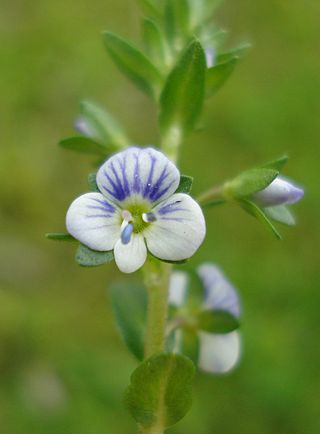
Veronica serpyllifolia, the thyme-leaved speedwell or thymeleaf speedwell, is a perennial flowering plant in the plantain family. The species as a whole is native mostly to Eurasia & North America, and has three variants with their individual ranges; var. serpyllifolia has particularly spread beyond its native range.
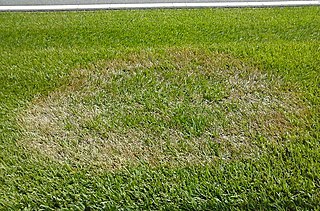
Brown patch is a common turfgrass fungal disease that is caused by species in the genus Rhizoctonia, usually Rhizoctonia solani. Brown patch can be found in all of the cool season turfgrasses found in the United States. Brown patch is most devastating to: Bentgrass, ryegrass, Annual bluegrass, and Tall fescue. Brown patch is also found in Kentucky bluegrass and Fine fescue but this is rare or does minimal damage. Brown patch is known as a foliar disease, so it does not have any effect on the crown or roots of the turf plant.
Pythiumdisease, also known as "Pythiumblight," "cottony blight," or "grease spot," is a highly destructive turfgrass disease caused by several different Pythium species. All naturally cultivated cool-season turfgrasses are susceptible to Pythium and if conditions are favorable to Pythium it can destroy a whole turfgrass stand in a few days or less. Pythium favors hot and very humid weather and will usually develop in low areas or swales in the turfgrass.

The European chafer is a beetle of the family Scarabaeidae. Formerly found only in continental Europe, this invasive species is now found at temperate latitudes in North America. The large, white grubs of A. majale feed on the roots of most cool-latitude grasses, both wild and cultivated. This has made the European chafer an enemy of lawns.

Paspalum vaginatum is a species of grass known by many names, including seashore paspalum, biscuit grass, saltwater couch, silt grass, and swamp couch. It is native to the Americas, where it grows in tropical and subtropical regions. It is found throughout the other tropical areas of the world, where it is an introduced species and sometimes an invasive weed. It is also cultivated as a turfgrass in many places.

Stachys floridana is a species of betony in the mint family, Lamiaceae. It is native to the United States, where its true native range is probably limited to Florida, but today it is known throughout the Southeast as an introduced species and common weed. It occurs as far west as Texas, and it has been recorded in California. Its common names include Florida betony, Florida hedgenettle, and rattlesnake weed. It has been called wild artichoke, but it is not closely related to artichoke. The plant was the Florida Department of Agriculture's "Weed of the Month" for February 2010.

Multiplex sensor is a hand-held multiparametric optical sensor developed by Force-A. The sensor is a result of 15 years of research on plant autofluorescence conducted by the CNRS and University of Paris-Sud Orsay. It provides accurate and complete information on the physiological state of the crop, allowing real-time and non-destructive measurements of chlorophyll and polyphenols contents in leaves and fruits.
Necrotic ring spot is a common disease of turf caused by soil borne fungi that mainly infects roots (4). It is an important disease as it destroys the appearance of turfgrasses on park, playing fields and golf courses. Necrotic Ring Spot is caused by a fungal pathogen that is an ascomycete that produces ascospores in an ascocarp (6). They survive over winter, or any unfavorable condition as sclerotia. Most infection occurs in spring and fall when the temperature is about 13 to 28 °C (5). The primary hosts of this disease are cool-season grasses such as Kentucky bluegrass and annual bluegrass (6). Once turf is infected with O. korrae, it kills turf roots and crowns. Symptoms of the disease are quite noticeable since they appear as large yellow ring-shaped patches of dead turf. Management of the disease is often uneasy and requires application of multiple controls. The disease can be controlled by many different kind of controls including chemicals and cultural.

Zoysia tenuifolia is a type of grass originally thought to be one of the native grass type to the Mascarene Island. The epithet tenuifolia is commonly used to describe plant specimens in Mascarene Islands and Zoysia tenuifolia is also called Mascarene grass.Korean grass is another common name for this species. Z. tenuifolia is not widely used as a general lawn grass due to its slow growth rate and tendency to form clumps, although this species is commonly bred with Zoysia japonica to create popular hybrid zoysia cultivars, such as Emerald and Geo.



